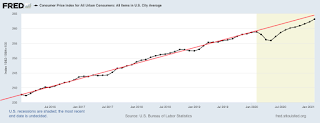The following table shows the annualized inflation rate in the 2 years before each recent recession, the inflation rate in the 2 years after each recent recession, and the differences between them.
I am not a believer in the economy will soon overheat theory. A $1.9 trillion stimulus package might sound like a shockingly large sum of money, but let's put this in perspective.
Household net worth now stands at $123 trillion and has grown $63 trillion since the Great Recession in 2009. By comparison, $1.9 trillion is like loose change found in the couch.
Our exponentially growing monetary addiction requires ever increasing sums just so the wheels don't fall off. Has anyone actually considered that $1.9 trillion might not be enough?
Ten Rhetorical Stimulus Questions
1. Are we supposed to be shock and awed by a $1.9 trillion stimulus package that's only equivalent to 1.5% of household net worth?
2. What if savers continue to save?
3. Are we counting on savers to spend?
4. Are we counting on spenders to spend what they've already spent?
5. How does one hoard services?
6. If there really is pent-up demand for haircuts, will people be getting twice as many over the next 2 years?
7. How much of a $1400 stimulus check would we need to save to earn $4.20 in annual interest in an online savings account that only has a 0.3% interest rate?
8. Should we use the $1400 instead to buy 100+ fast food meals, 2 shares of Tesla @ $674, or 5 shares of GameStop @ $247?
9. Easy come, easy go. Am I right?
10. Human sacrifice? Dogs and cats living together? Mass hysteria?
Humans needlessly sacrificed, dogs and cats living together, mass hysteria. It's been quite a year.


















